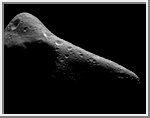|
COMETS EARTH JUPITER KUIPER BELT MARS MERCURY METEORITES NEPTUNE OORT CLOUD PLUTO SATURN SOLAR SYSTEM SPACE SUN URANUS VENUS ORDER PRINTS
PHOTO CATEGORIES SCIENCEVIEWS AMERICAN INDIAN AMPHIBIANS BIRDS BUGS FINE ART FOSSILS THE ISLANDS HISTORICAL PHOTOS MAMMALS OTHER PARKS PLANTS RELIGIOUS REPTILES SCIENCEVIEWS PRINTS
|
Related Document
Download Options
NEAR takes several images mosaics of Eros daily for purposes of navigating the spacecraft. The one shown here was taken February 29, 2000, from a range of 289 kilometers (180 miles). It shows features as small as 30 meters (100 feet) across. All of the mosaics show the same territory over and over, but changes in lighting plus the gradual decrease in the spacecraft's range to the surface are both constantly bringing out new details. The very oblique illumination in this mosaic is ideal for bringing out small landforms. Many parts of the asteroid have "grooves," linear troughs about 100 meters (330 feet) wide and several kilometers long. Similar features have also been observed on other asteroids such as Gaspra, and they are especially numerous on Mars' moon Phobos. Their origin isn't completely understood, but formation of the grooves probably involves fracturing of the asteroid's subsurface in some way. (Mosaic of images 0127210446, 0127210510, 0127210574, 0127210656) |
